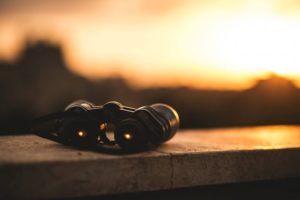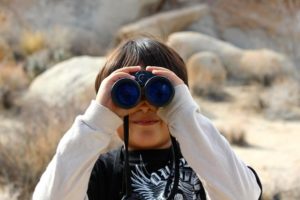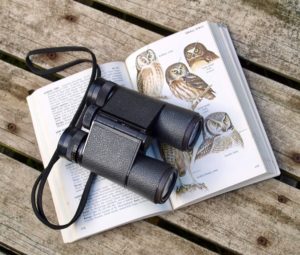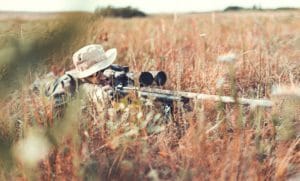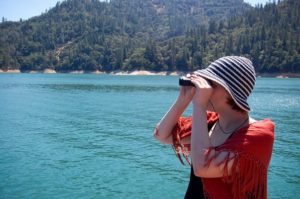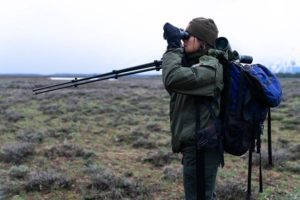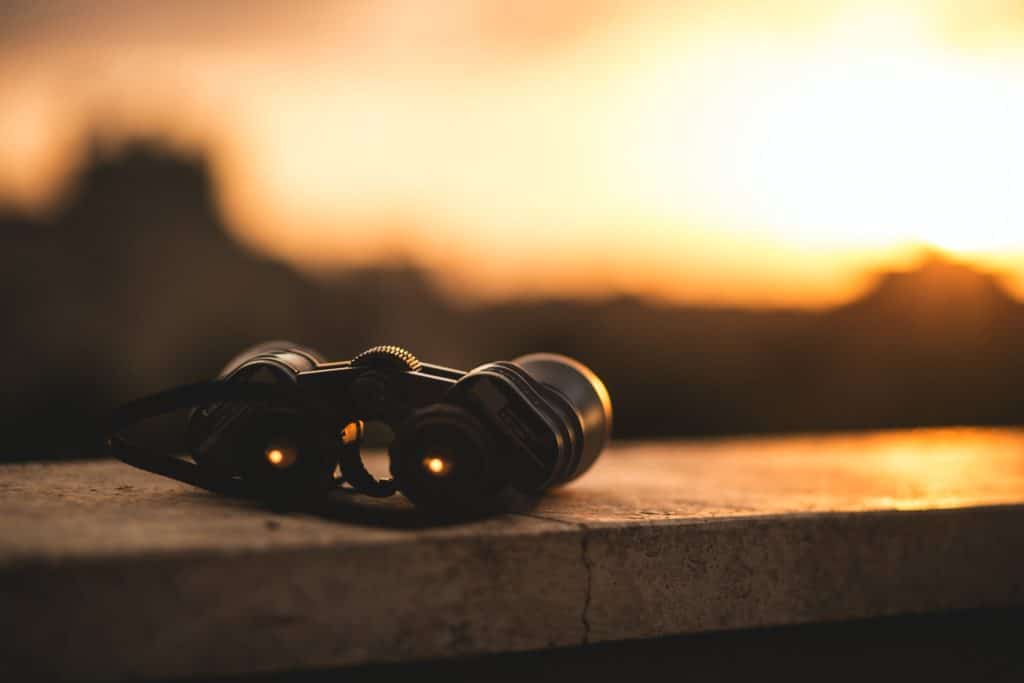Disclaimer: This article includes affiliate links. If you choose to purchase any of the products discussed in this article, we may receive a small commission.
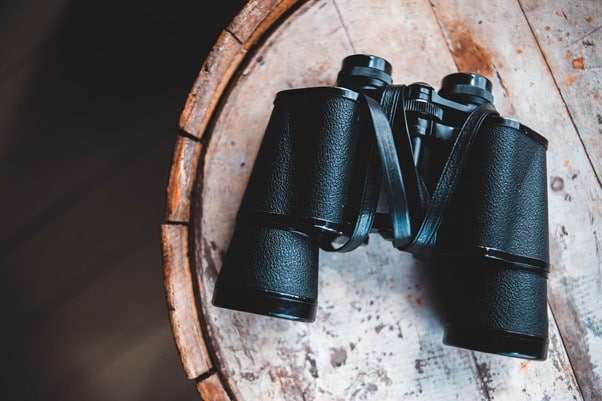
Being on safari comes with its own set of challenges. For the best experience, it is necessary to have the correct equipment. Binoculars are no exception to this rule. The last thing you want is to be fiddling around with a pair of unsuitable binoculars when the splendors of the Savanna are unfolding right before your eyes.
It is the purpose of this article to make sure that this never happens. In it, we shall roundup and rundown the best binoculars for safari that are currently available—considering optics, clarity, weight, and durability, among other things.
But before we do that, let’s start by outlining “what to look for” when it comes to selecting the best binoculars for safari.
If you simply want the products, here are the top 8 Best Binoculars for Safari:
- Vortex Diamondback HD Binoculars
- Nikon MONARCH M5 Binoculars
- Vortex Viper HD Binoculars
- Bushnell H2O Binoculars
- Celestron Nature DX Binoculars
- Steiner Safari UltraSharp Binoculars
- Nikon PROSTAFF 7s Binocular
- Steiner Predator Binoculars
What to Look for in the Best Binoculars for Safari
What follows is a list of criteria by which to judge binoculars. And in this case, criteria for establishing the best binoculars for safari.
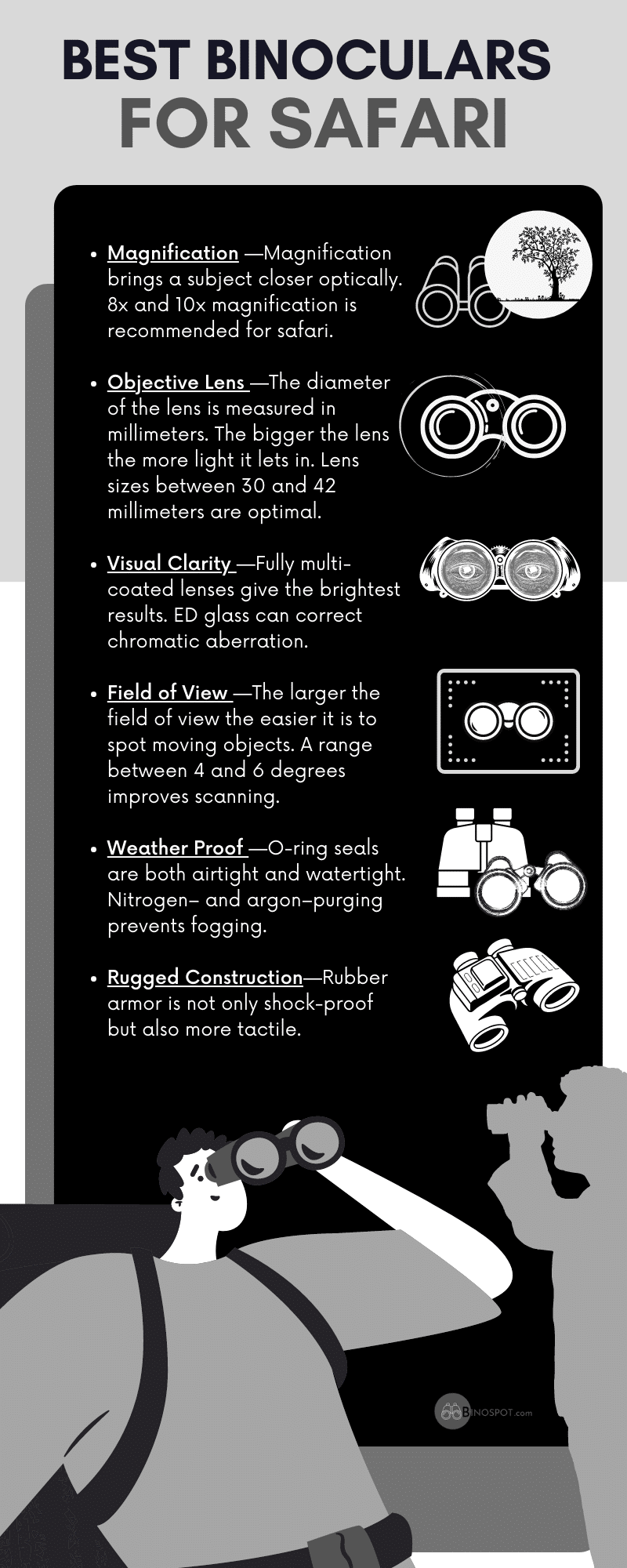
Magnification and Lens Diameter
The key to understanding binoculars and how they work is in magnification and lens size. Binoculars are defined by these two sets of numbers or specifications.
For example, a number like 10×42 refers to a magnification of 10 times and a lens diameter of 42. Straightforward enough, but what do those numbers mean?
Well, the first number, 10, refers to the magnification properties of the lens. In other words, the binoculars will make everything appear ten times closer or ten times bigger than with the naked eye. While the 42 indicates the diameter of the lens in millimeters. The bigger the number, the larger the lens. Larger lenses let in more light. More light leads to a clearer image.
More light for a brighter image is desirable, but it is worth remembering that greater lens size and magnification come with additional bulk. Not something you necessarily want when you’re on safari.
It is also important to know that increased magnification reduces the field of view. In other words, when you’re brought closer to something optically, then the surrounding visible area in the image is smaller. This effect means movements are also magnified, requiring a steady hand to keep the action in view.
Understanding the relationship between magnification and lens size is fundamental to the understanding of binoculars and what you are going to get out in the field.
A magnification of around 8x to 10x is ideal for Safari. Anything more becomes cumbersome. Lens size should be between 30 and 42 millimeters. Too small, not enough light. Too big, and the binoculars become a burden.
Exit Pupil Size
In addition to the two big numbers of magnification and lens diameter, let’s add a third, exit pupil size.
Exit pupil size determines the amount of light entering the binoculars and consequently plays a big part in image quality.
Typically exit pupil size is displayed in conjunction with the lens diameter. For safari, an exit pupil size/lens diameter of 7×35 or 8×40 millimeters is something to aim for.
If you’ve opted for very lightweight binoculars, 8×25 might be all you get. Remember this reduced lens diameter will lead to a tradeoff in low light settings.
Field of View
Staying with optics. When it comes to safari, it’s best to get as wide a field of view as possible.
Angular field of view (FoV) is measured in degrees. Binoculars that range between 4 and 6 degrees are a safe bet. An FoV in that region gives you better scanning and will make sure you can spot animals that much more quickly.
Visual Clarity
Light reflection can diminish image quality and sharpness. This is where optical coatings come in. Multi-coated and high contrast coatings deliver the best results.
To further enhance visual clarity, ED glass, aka Extra-low Dispersion Glass, corrects the natural refraction of light. This prevents something called chromatic aberration. Chromatic aberration is an optical problem that occurs when a lens fails to bring all wavelengths of color to the same focal plane, leading to color distortion.
Not ideal when gazing at the rainbow colors of nature.
ED glass is typically found in high-end binoculars, so it comes at a price. Nonetheless, we believe it to be a worthwhile consideration when selecting a pair.
Ease of Focus
Tuning an image to find focus is something that needs to be done rather quickly on safari. A large, smooth, and easy-to-grip focus wheel will make things significantly easier in this respect and should be a feature to look out for when buying.
Fast focus binoculars claim to bring down focus tuning times by one-fifth. At the very least, look for a central focusing wheel, requiring minimal rotation.
Ergonomics
Size, weight, and feel are critical factors in the selection of binoculars. If you’re going to spend a long day out in the field, then the last thing you want is to lug around binoculars that weigh you down.
As for the feel, a rubber coating will give you all the grip and tactility you need.
Remember, the more compact and lightweight binoculars have a smaller lens diameter, which means they will work less well in lower light settings.
Consider your needs carefully.
Weatherproof
Waterproof and fog-proof binoculars are essential for going on safari. Rain, moisture, and temperature extremes can play havoc with your binoculars if they’re not protected.
When it comes to waterproofing, look for the ingenious “O-ring,” which indicates your binoculars are both airtight and watertight. As for the question of fogging, the feature “nitrogen- or argon-purging” is desirable. These inert gases guarantee there is no moisture in your optical barrels and that they do not condense.
Fog proofing and waterproofing generally go hand in hand.
Shockproof
The terrain you encounter when on safari can be unforgiving. Rough, bumpy roads can lead to the rapid decommissioning of a pair of binoculars due to damage.
This is why it is essential to look for rugged armoring in binoculars. A rubber coating is not only shockproof but also a little more tactile to hold, so it has a dual purpose.
Long Eye Relief
As you are almost certainly going to be wearing some eyewear, Long Eye Relief is a pretty important feature when considering the best binoculars for safari.
Binoculars are fitted with eyecups that you can adjust by either pulling or turning. These adjustments make the eye relief shorter or longer, to accommodate both naked eyes and glasses.
The amount of long eye relief you need depends on several factors, including the kind of eyewear. However, it is generally believed that something in the region of 16mm is sufficient.
The Best of the Best Binoculars
So without further ado, our selection of the best binoculars for safari:
1. Vortex Diamondback HD Binoculars—Overall Winner
If you’re looking for binoculars that refuse to sacrifice performance for the sake of price, then the Diamondback HD binoculars should be your first choice.
The Vortex Diamondback 10×42 binoculars boast an HD Optical System designed to maximize resolution, minimize chromatic aberration, and produce exceptional color fidelity—to give you excellent “edge-to-edge” sharpness and image brightness.
The Vortex Diamondback HD binoculars do rather well in the design department too. A durable, lightweight magnesium chassis is rugged enough to withstand the kind of bumps and shocks you would expect on safari. While fog proof and waterproof features mean that the Diamondback HD binoculars are ready for just about any conditions you care to throw at them.
Adjustable eyecups and a center focus wheel complete the package on what are extremely capable safari binoculars.
Pros
- HD optical system.
- Fully multi-coated.
- ArmorTek scratch-resistant coating.
- Adjustable eyecups.
- Roof prism provides durability and compactness.
- Short hinge design.
Cons
- Not the best eye relief.
2. Nikon MONARCH M5 Binoculars—First Runner Up
The Nikon MONARCH M5 Binoculars are another pair of binoculars particularly suited to safaris.
Featuring ED (Extra-low Dispersion) glass, the MONARCH M5 binoculars are almost distortion, aberration, and color fringing, free. The “wide” 42 mm objectives deliver high-resolution views in even the most challenging light conditions. While 10x magnification means you’ll never be a long way from the action.
Not that the MONARCH M5 binoculars sacrifice the “near” for the sake of the far. You can get as close as 8.2 feet from your subject— if you dare to.
The high-eyepoint design of the MONARCH M5 leaves just enough space between your brow and the eyecups for supreme comfort, as well as an unobstructed field of view—even if you happen to be wearing glasses. While turn-and-slide operation means you can get the rubber eyecups just where you want them—boosting operational comfort and convenience.
Fitted out in a rubber-armored body, the MONARCH M5 binoculars are both fog proof and waterproof: So they are just as intrepid as you are.
Pros
- Wide FoV.
- A large central focus knob.
- ED (Extra-low Dispersion) glass.
- Close focusing range of 8.2 feet.
- Turn-and-slide rubber eyecups.
- Rugged construction.
- Lightweight 22.6 ounces.
Cons
- Poor lens caps.
3. Vortex Viper HD Binoculars—Second Runner Up
The Vortex Viper HD 10×42 binoculars possess all the qualities associated with premium safari binoculars.
HD lens elements boast extra-low dispersion to deliver tip-top resolution and color fidelity. While a proprietary XR multi-coating increases light transmission to illuminate the dullest of scenes with edge-to-edge clarity.
In terms of construction, rubber armor takes care of feel and durability. The lenses of the Vortex Viper HD are protected by ArmorTek.
Fogproof and waterproof, courtesy of argon gas purging and O-ring seals, Viper HD binoculars also feature adjustable eyecups and a center focus wheel so that you are always staring down both barrels.
Highly recommended for any safari.
Pros
- Premium extra-low dispersion glass.
- Multi-Coated.
- Center Focus Wheel.
- Rubber armor durability.
- Lifetime warranty.
Cons
- Price.
4. Bushnell H2O Binoculars
The Bushnell H20 10×42 binoculars are designed to excel in even the most challenging conditions.
Featuring multi-coated optics and top-notch BaK-4 prism glass, the H20 binoculars maximize light transmission to deliver sparkling levels of brightness and clarity.
O-ring sealed and nitrogen purged for waterproof and fog-free performance, respectively, the H20 binoculars are equipped to deal with the harshest of environments.
The non-slip rubber armor is designed to absorb any unexpected shocks and provide the kind of grip you need on an action-packed safari.
Twist-up eyecups, a large center focus, and longer eye relief complete the package.
Pros
- Multi-coated optics.
- 100 percent waterproof.
- Long eye relief.
- Soft Texture grip.
Cons
- Not the best close focus.
5. Celestron Nature DX Binoculars
Celestron Nature DX 8×42 binoculars are the perfect companion to any outdoor adventure, including safari.
Nature DX binoculars feature high-quality BaK-4 prisms and are phase coated to give you the very best in brightness, contrast, and resolution, even when in poor light conditions.
With 8x magnification and 42mm objective lenses, you can single out subjects quickly and follow them easily in the wide field of view. Nature DX binoculars can even maintain focus as close as 6.5 feet, allowing you to get up close and personal should you wish to.
The Celestron Nature DX binoculars are armored in durable rubber, feature twist-up eyecups, and are fog proof and waterproof.
Impressive specifications for entry-level binoculars.
Pros
- Phase-coated BaK-4 prisms and fully multi-coated optics.
- Polycarbonate housing.
- Waterproof and fog proof.
Cons
- Poor quality carry case.
6. Steiner Safari UltraSharp Binoculars
As the name suggests, the Steiner Safari Ultrasharp 10×26 binoculars are portable, durable, and sharp-sighted enough for all the demands of being on safari.
10x magnification combined with 26mm lens diameter gives the Steiner Safari Ultrasharp binoculars power without the bulk. This exceptional portability is complemented by Steiner’s ClicLoc system. ClicLoc enables push-button neck strap attachment or release to ensure that your binoculars are always ready for action.
Encased in a rugged “Makrolon” housing, waterproof and fog proof, the Steiner Safari Ultrasharp binoculars should be on everyone’s list of safari contenders.
Pros
- Supremely compact.
- Lightweight and durable polycarbonate chassis.
- Makrolon Housing withstands 11 Gs of impact.
- Waterproof and Fogproof.
- ClicLoc system for push-button neck strap release.
Cons
- No tripod mount.
7. Nikon PROSTAFF 7s Binoculars
The Nikon PROSTAFF 7s 8×30 Binoculars are lightweight, high-performing, and ideally suited to outdoor activities such as safaris.
Nikon PROSTAFF 7s binoculars deliver sterling sharpness and clarity courtesy of fully multi-coated eco-glass lenses and phase-correction coated roof prisms to get the very best from the action that surrounds you.
And wielding all this optical power couldn’t be easier or more comfortable, thanks to an ergonomic rubber-armored body.
Fogproof, waterproof, and fitted with turn-and-slide rubber eyecups, a full field of view with optimal comfort is a reality.
Pros
- Compact.
- Advanced optics.
- Armored body.
- Waterproof and fogproof.
Cons
- Heavy.
8. Steiner Predator Binoculars
The Steiner Predator 10×42 binoculars are all about all-around capabilities.
The Predator series of binoculars feature something called CAT (Color Adjusted Transmission). CAT coatings deliver exceptional low-light performance so that you can spot “game” in just about any setting.
A lightweight Roof Prism design combined with Fast-Close-Focus means that the Predator 10×42 binoculars are quick and agile enough for even the most dynamic of contexts.
Durability and grip are provided by Steiner’s Makrolon housing. This ability to stand up to the harshest conditions is further galvanized by an N2 injection system for state-of-the-art fog proofing.
The Steiner Predator 10×42 binoculars are a strong addition to this list of best binoculars for safari and should not be underestimated.
Pros
- CAT Color Adjusted Transmission boosts contrast.
- Fast Close-Focus.
- N2 injection fog proofing.
- ClicLoc system for push-button neck strap release.
Cons
- Eye relief not specified.
FAQ
Are binoculars with extremely high magnification any good?
Binoculars with high zoom ratios such as 50x or 100x become extremely difficult to use when fully zoomed. The field of view becomes too narrow to observe objects effectively, and the exit pupil size becomes so small as to darken everything you see.
The biggest problem, though, is that every little movement of the hand will be magnified too, rendering hand-held use almost impossible.
To Summarize
Selecting the best binoculars for safari should be based on magnification, image clarity, durability, and ease of use. 10×42 lenses are considered ideal for safari as they give you the optimum power and clarity you’ll need. A field of view of 6-8 degrees is ideal to assist with scanning.
Weatherproofing is also a necessity. O-ring seals help waterproof. Fogging is taken care of by nitrogen– and argon–purging.
Look for rubber armor to protect your binoculars from inevitable knocks and scratches.
Our overall winner are the Vortex Diamondback Safari Binoculars because they covered all the bases so competently. But any of the binoculars on the list would make the perfect companion for your next safari.
So go ahead, take your pick.









